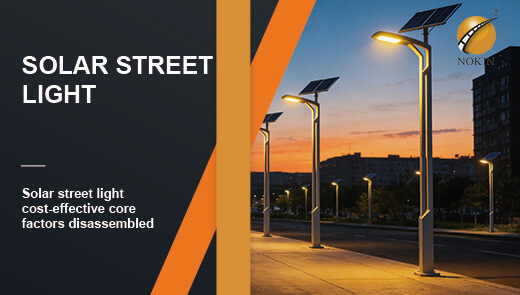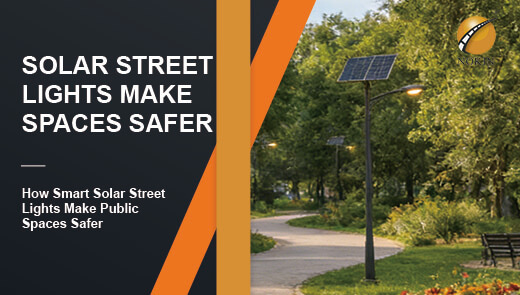High-Quality Solar Street Lights International Standards
As the global low-carbon transition accelerates, solar street lights have become the mainstream lighting choice for urban thoroughfares, rural roads, tunnels, and various other scenarios due to their advantages of zero electricity costs, flexible installation, and pollution-free operation. However, their lighting performance directly impacts nighttime traffic safety, pedestrian visual comfort, and even the surrounding ecological environment. The International Commission on Illumination (CIE) and relevant national bodies have established standards covering key metrics such as lighting uniformity, color temperature, and color rendering. These standards serve as both technical benchmarks for manufacturers and core criteria for purchasers to evaluate product quality.
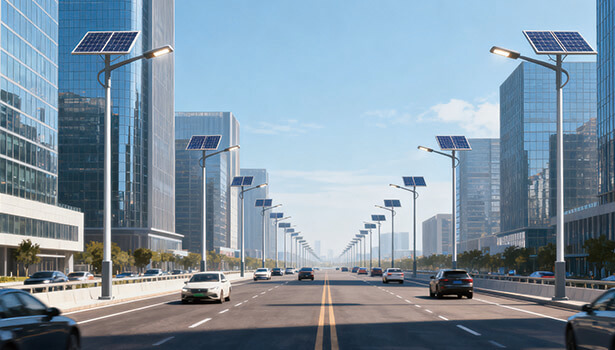
Uniformity in Solar Street Lighting
What is Lighting Uniformity?
Lighting uniformity refers to the evenness of light distribution across road surfaces created by solar street lights, serving as the primary indicator for assessing lighting quality. According to the CIE definition, uniformity is primarily measured through two ratios:
- Minimum illuminance / Average illuminance: Reflects the difference between the lowest brightness on the road surface and the overall average brightness. A higher ratio indicates fewer dark areas.
- Minimum illuminance / Maximum illuminance: Reflects the difference between the darkest and brightest points on the road surface. A ratio closer to 1 indicates more balanced illumination.
It is important to note that uniformity measurements must adhere to international standards: Data collection requires a 2m × 2m grid pattern within 1.5 times the lamp post height directly below and on both sides of the street light. Calibrated professional illuminance meters (accuracy ≥ ±5%) must be used to ensure comparable results.
Why is Uniformity a Mandatory Requirement in International Standards?
Increased visual fatigue: “Bright spots” and “dark gaps” on the road surface force pedestrians and drivers to frequently adjust pupil size to adapt to light changes. Prolonged exposure can lead to dry, sore eyes, posing higher risks in high-speed scenarios like highways.
Increased safety hazards: Dark zones conceal obstacles (e.g., potholes, pedestrians, non-motorized vehicles). According to CIE statistics, road sections with solar street light uniformity below 0.3 experience a 37% higher nighttime accident rate than those with uniformity ≥0.4.
Therefore, whether it's the European EN standards, the American IES RP-8 road lighting guidelines, or China's GB/T 31983-2015 standard, uniformity is mandated as a compulsory requirement for LED solar street lights.
International Uniformity Requirements for Different Road Types
As traffic demands vary across different scenarios, international standards also differ in their uniformity requirements for LED street lights, as detailed in the table below:
|
Road Type |
Typical Scenario |
Minimum / Average Illuminance Requirement |
Example Applicable Areas |
|
Urban Main Road |
Heavy traffic, speed ≥ 60 km/h |
≥ 0.4 |
Europe, North America, major cities in China |
|
Residential Road |
Speed ≤ 30 km/h, pedestrian-dense |
≥ 0.3 |
Residential areas worldwide |
|
Rural / Remote Road |
Low traffic, basic lighting needs |
≥ 0.2 |
Rural areas in Africa, Southeast Asia |
|
Tunnel / Underpass |
Sudden light changes, requires transition lighting |
≥ 0.5 |
Tunnel projects worldwide |
Color Temperature Refers to the Hue of Solar Light, Measured in Kelvin (K)
The Scientific Definition and International Measurement Standard of Color Temperature
Color temperature denotes the hue of light emitted by a source, measured in Kelvin (K). It simulates the color shift of an “absolute black body” when heated: lower temperatures produce a more yellowish light, while higher temperatures yield a whiter, bluer light. Internationally standardized color temperature measurement requires a spectrophotometer to collect spectral data from the light source's central intensity region under rated operating current. The calculated color temperature must maintain an error margin within ±200K (compliant with CIE 15-2018 standards).
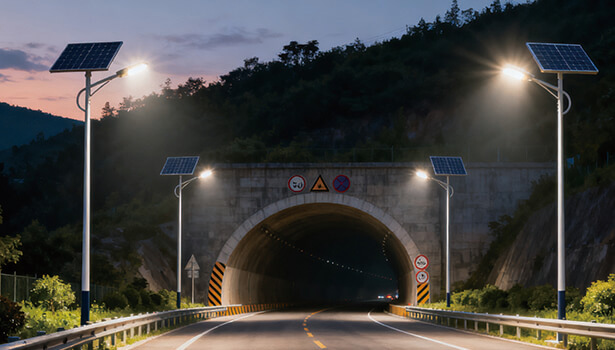
Characteristics of High/Low Color Temperature Solar Street Lights and Recommended International Applications
Low Color Temperature (Warm Light: <3500K)
- Visual Characteristics: Light appears pale yellow with soft illumination and minimal glare, creating a warm, comfortable ambiance.
- Core Advantages: Strong penetration through fog and dust; in high-humidity or foggy environments, illumination distance extends 15%-20% farther than high-color-temperature lamps.
- Internationally Recommended Scenarios: Residential areas, parks, pedestrian streets (avoiding strong light disturbing residents' rest).
High Color Temperature (Cool Light: >5000K)
- Visual Characteristics: White or pale blue light with sharp illumination, enhancing object contour clarity and visual recognition.
- Core advantage: At equivalent illuminance levels, high-color-temperature lamps deliver 20%-30% higher “visual brightness” than low-color-temperature lamps, ideal for scenarios requiring rapid obstacle detection.
- Internationally recommended applications: Urban thoroughfares, highways, intersections (meeting high-speed traffic visual demands).
International Consensus on Color Temperature for Solar Street Lights
International standards explicitly oppose solar street lights with extreme color temperatures for the following reasons:
Excessively high color temperature (>6500K): Emits cold blue light that irritates the retina, causing visual fatigue. Additionally, cold light disrupts nocturnal insects' photo taxis, damaging ecological balance (CIE 195-2018 report indicates street lights above 6500K reduce surrounding insect populations by 12%).
Excessively low color temperature (<2700K): Light appears overly yellow, reducing color recognition of objects—such as making red traffic lights appear “faded”—and increasing misjudgment risks.
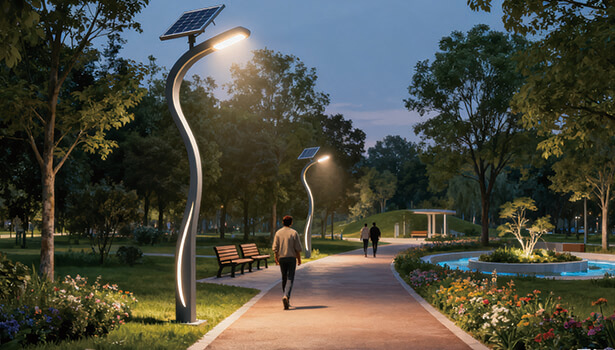
The Degree of Color Reproduction of the Solar Street Light
Definition and Core Metric of Color Rendering (CRI/Ra)
Color rendering refers to a solar street light's ability to reproduce the true colors of objects. The core metric is the Color Rendering Index (CRI), denoted as Ra (range 0-100):
Ra=100: Reproduces 100% of an object's color under natural light, representing an ideal state;
Ra≥80: Excellent color rendering, suitable for scenarios requiring high color recognition accuracy;
Ra < 60: Poor color rendering, causing color distortion (e.g., red appearing orange, green appearing yellow).
International standards (CIE 13.3-1995) stipulate that solar street lights for public areas must have an Ra value no lower than 50, serving as the “minimum threshold” for basic color recognition.
International Color Rendering Requirements for Different Scenarios
|
Application Scenario |
Minimum Color Rendering Index (Ra) Requirement |
Core Reason |
|
General Roads |
≥ 60 |
Distinguish pedestrian clothing and vehicle colors, avoid misidentification due to color distortion |
|
Intersections, School Zones |
≥ 70 |
Accurately recognize traffic lights (red/yellow/green), school uniforms, and warning signs |
|
Tunnel Entrances/Exits |
≥ 75 |
Transition from "dark" to "bright"; high color rendering helps eyes adapt and prevents the "black hole effect" |
|
Commercial Pedestrian Streets |
≥ 80 |
Support shop window displays, facial/makeup recognition, and enhance commercial atmosphere |
The Practical Value of Color Rendering Compliance
- Enhanced Traffic Safety: Under street lightswith Ra≥70, drivers can identify red vehicles from 8-10 meters farther than under Ra=50 lighting, allowing more time for emergency braking.
- Supporting Public Safety: Urban surveillance cameras under high-CRI lighting clearly capture pedestrian clothing colors and facial features, providing effective investigative leads—a core requirement for “lighting + surveillance” integration in global smart city development.
How to Verify Solar Street Lights Meet International Standards?
For purchasers (e.g., governments, engineering firms) or end-users, product compliance can be verified through these 3 steps:
Verify International Certification
Prioritize solar street light products with the following international certifications, which cover multi-dimensional standards including safety, performance, and environmental protection:
CE Certification (Europe): Complies with standards like EN 13201 and EN 61215, enabling free sale across the 27 EU member states and the European Economic Area (EEA).
UL Certification (USA): Meets UL 1973 (energy storage systems) and UL 1598 (lighting equipment) standards, satisfying North American market safety requirements.
SAA Certification (Australia): Complies with AS/NZS 60598 (Lighting) and AS/NZS 4777 (Photovoltaic Systems) standards, suitable for the Oceania market.
Request Third-Party Test Reports
Require manufacturers to provide test reports from authoritative third-party institutions such as SGS, focusing on verifying the following data:
Lighting Performance: Uniformity (minimum/average illuminance ratio), color temperature, color rendering index (Ra).
Component Performance: PV panel conversion efficiency, battery cycle life, charge/discharge efficiency.
Environmental Adaptability: High/low temperature operation performance, IP protection testing, wind load resistance testing.
International standards for high-quality solar street lights encompass comprehensive specifications—from rational light distribution and color adaptation to performance stability. Whether addressing uniformity requirements to prevent “bright spots and dark gaps,” ecological considerations limiting extreme color temperatures, or color rendering standards ensuring visual recognition, all revolve around the core objectives of “safety, efficiency, and environmental protection.” Implementing these standards through verifying international certifications and requesting third-party test reports not only propels the industry beyond “low-quality, low-price” competition but also provides a solid foundation for optimizing global nighttime lighting environments.

